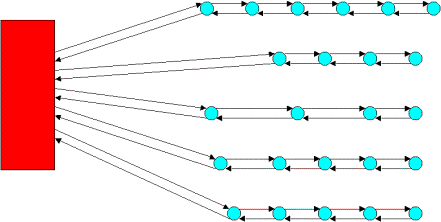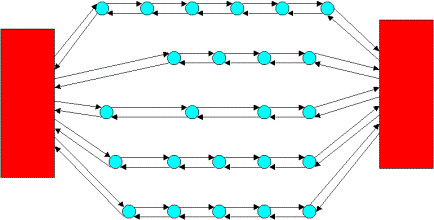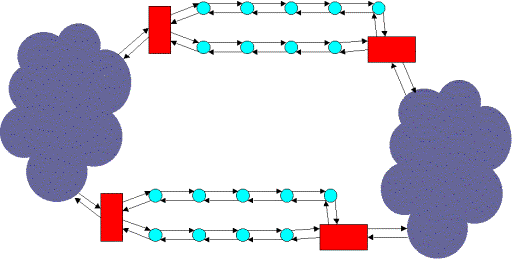

A network consists of "nodes" which are linked together directly or via RouteLive switches, which in turn may be linked to each other directly or via other network technologies.
Each "node" has two network interfaces, currently to the same standard as 100Base-TX fast Ethernet (RJ45 connector, up to 100 metres of category 5 twisted pair cable); Neutrik's EtherCon RJ45 connector in an XLR shell is used where a more rugged connector is required. A version using Gigabit Ethernet is planned for 2004.
Several configurations are possible. The simplest is to link each node to the next in a daisy-chain:
![]()
The ends of the chain can be left unconnected as in the diagram, in which case the chain is referred to as a "linear segment". An unconnected link really is unconnected; no termination is required. The ends of the chain may also be linked together to form a dual ring, giving the added resilience required for safety-critical applications:

There is no limit to the number of nodes on a ring or linear segment.
Using switches, the network may be star-connected in the same way as fast Ethernet. The second network interface on each node may be used as a "follow-on" connector, allowing several nodes to share each switch port:

Resilience may be achieved by connecting one end of each daisy-chain into one switch and the other end into another:

Switches may be linked via an ATM network. Connections between nodes on different segments can made via switched virtual circuits on the ATM network, or "permanent virtual path" connections between the various locations can be used to form a virtual private network.
A pair of switch ports may be used as part of a dual ring, and the connection between rings on different sites may be fully duplicated:

The AL020 has a 155 Mbit/s ATM interface as well as two Ethernet interfaces; the ATM interface may be used to connect to an ATM network, or connected (via a cross-over cable) to an AL020 elsewhere in the segment (or in another segment) to give added resilience.
------------- ooo OOO ooo -------------
Copyright ©2001-2003 Nine Tiles Networks Ltd